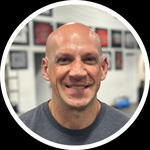Case Study: More than Just Rotator Cuff Exercises
I had a one-time consultation client at Cressey Performance yesterday, and when I noticed that he had some interesting stuff going on, it made me realize that I need to do more “case studies” here in the blog.
This guy had a history of on-and-off right-sided lower back and left shoulder pain. Basically, it would act up every once in a while, then calm down when he cut out exercising. Then, he’d return to training for a bit – only to have another set-back. It has been one step forward, and one step back for years.
Now, if you’d seen this guy move, you’d realize that the lower back and shoulder stuff were clearly closely related. If you’re at all familiar with the Postural Restoration Institute, he was a classic Left AIC pattern: adducted/internally rotated right hip and abducted/externally rotated left hip – and the compensations working their way up to lead to a low right shoulder and prominent left rib flair. Everything was definitely related.

Not surprisingly, he’d been told he had scoliosis previously – but the “interesting” thing about it is that this was an acquired posture. He hadn’t had these when he was a kid; he developed them when he was a rower who was always on the right side of the boat. If you can acquire them, you can “unacquire” them – but it takes time.
We’re getting him started on some drills to iron out his hip imbalances, but for the sake of this blog, I wanted to highlight what we saw with his shoulder, as I think it includes some great take-home messages on how to manage shoulder function – both in the presence and absence of pain.
If you look at the research, if you look at shoulder total motion (internal rotation + external rotation with the scapula stabilized at 90 degrees of abduction), you should see symmetry between right and left in a healthy shoulder. The internal and external components may be different between sides (e.g., more external rotation and less internal rotation in a throwing shoulder), but the total motion should be the same. When it’s not, “normalizing” total motion should be a primary goal, whether you’re trying to address or prevent shoulder issues.
In our case study’s situation, here is what we measured with the goniometer:
Left: 39° (IR) + 98° (ER) = 137° (TM)
Right: 58° (IR) + 109° (ER) = 167° (TM)
In other words, it was a 30° total motion deficit, with most of that deficit coming from internal rotation.
The logical next step would be to manually stretch the shoulder girdle, right? Well, certainly, it may be justified. However, before I go having an athlete crank on a somewhat “delicate” joint, I like to see what we can do to get that area to relax without even touching it.
The first thing we did was simply close down that left rib cage flair a bit while flexing his left hip and flexing his left arm overhead. And, we just left him there to breath for 30 seconds or so. Then, we remeasured:
Left: 44° (IR) + 104° (ER) = 148° (TM)
In other words, we got 11° of total motion without ever touching his shoulder. His body did that work just by getting air in with a new posture (no left rib flair).
Next, I simply had him get on all fours and go through a pretty low-key thoracic spine mobilization with his arm gently positioned behind his back so that it was on absolutely no stretch. He did eight reps on each side, using cervical motion to drive a bit of thoracic extension and rotation and scapular movement. Then, we remeasured:
Left: 46° (IR) + 107° (ER) = 153° (TM)
There’s another 5° of total motion, and it got us a lot closer to where he needs to be – without ever touching his shoulder. And, the coolest part was that when he stood up, the low right shoulder was markedly less prominent – and it was a positioning that “stuck around” for the rest of his session.
Sure, manual stretching of the shoulder is probably warranted for him to get those last 14 degrees, and I don’t expect him to maintain all this range indefinitely after this session. He’ll need to be consistent with the movements to regain range bit-by-bit and use his strength training to ingrain it in his movement patterns, but the point is that the less aggressive, seemingly indirect, and self-applied interventions are often the best way to get lasting results. And, when they work, it makes you realize just how “synced up” our entire body is from head-to-toe.
For more information on the best assessments and corrective exercises for the shoulder, check out our Optimal Shoulder Performance DVD Set.
Related Posts
Shoulder Range-of-Motion Norms
Mobilizing the Throwing Shoulder: The Do and Don’t
Sign-up Today for our FREE Baseball Newsletter and Receive a Copy of the Exact Stretches
used by Cressey Performance Pitchers after they Throw!



